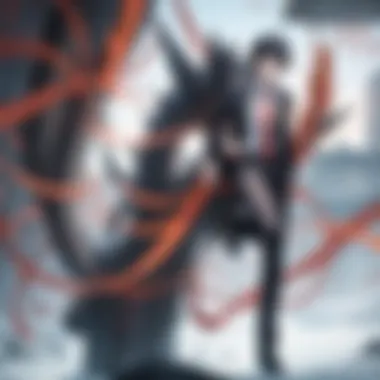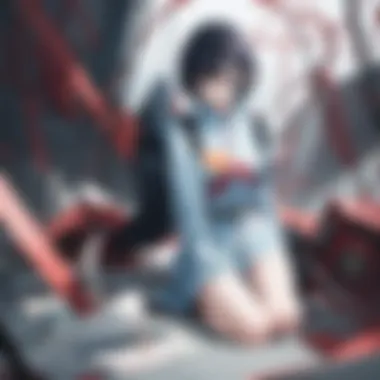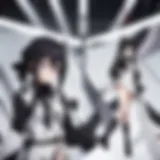An In-Depth Exploration of 'Parasyte' on Crunchyroll


Prelude to the Series
'Parasyte,' known in Japan as 'Kiseijuu,' is not just another anime to glide through the screens of Crunchyroll. This horror sci-fi series made its debut as a manga in 1988, penned by Hitoshi Iwaaki. The intricacies of its narrative paved a way to adaptation as an anime in 2014, capturing audiences with an unsettling yet captivating storyline. With a narrative that intertwines themes of survival and identity, 'Parasyte' strikes to the core of what it means to be human.
The plot revolves around Shinichi Izumi, a high school student whose life goes off the rails when alien parasites invade Earth. The initial premise seems straightforward: the parasites take over human bodies, but things take a twist when one of the parasites, Migi, fails to seize full control. Instead, it merges partially with Shinichi, leading to a bizarre cohabitation that culminates in profound existential battles.
As the series unfolds, it beckons audiences to delve deeper into humanity’s psyche, cleverly juxtaposing the human condition with the parasitic nature of both humans and aliens. The show’s genre blends horror with philosophical musings, presenting a reflection on society and morality.
In terms of popularity, 'Parasyte' has solidified its place in both manga and anime communities. It has garnered a strong following due to its unique premise, artistic style, and delightful character arcs. The tension between Shinichi and Migi showcases not just action but also an intriguing partnership that raises questions about trust and friendship.
In recent years, social media platforms have buzzed with discussions around the series, indicating its enduring relevance. Through fan arts on forums like Reddit, to in-depth analyses on platforms like Wikipedia, 'Parasyte' continues to resonate with longtime fans and newcomers alike, proving that its narrative depth and cultural themes are timeless.
"In 'Parasyte,' the real monsters are us, and that’s the horror hidden beneath the thrilling facade."
Below, we will explore the intricate elements that contribute to the series' acclaim, shedding light on its themes, character dynamics, and the creative minds behind this extraordinary adaptation.
Preface to 'Parasyte'
An essential starting point for any discussion about the anime series 'Parasyte' is understanding what makes it a noteworthy entry in the genre. This anime is not just another series tossed into the sea of available content. Instead, it poses profound questions about life, identity, and what it means to be human— topics that resonate deeply with viewers.
In a world overwhelmed by cookie-cutter narratives, 'Parasyte' emerges as a fresh perspective that stands out. It blends the horror of body snatching with philosophical inquiry. It's a series that compels its audience to ponder crucial issues, wrapping complex themes in a thrilling storyline. This dual nature—balancing entertainment with intellectual engagement—merits a closer examination.
Furthermore, the route through which 'Parasyte' has reached audiences, particularly on platforms like Crunchyroll, cannot be overlooked. Crunchyroll, catering to a global audience, acts as a bridge, making this profound narrative accessible to many fans. This discusses not just its entertainment value but how it transmits strong thematic relevance across different cultures.
We will explore not just the narrative and thematic elements, but also what makes the characters so compelling. Each character in 'Parasyte' embodies varied aspects of humanity, leading to rich character dynamics that fuel the story further. It's a multilayered experience that prompts viewers to engage, reflect, and often reassess their viewpoints.
In summary, the importance of the 'Introduction to Parasyte' section lies in setting the stage for a deeper exploration. By contextualizing its themes and characterizations, we can appreciate the broader implications of the series in anime culture. From the first glances into the world of Shinichi and Migi to the complex entanglements that follow, it's a journey worth taking.
The Plot Summary
Understanding the plot of Parasyte is crucial for grasping the series' core themes and character development. The narrative serves as a backbone, intertwining horror, philosophy, and existentialism, making it more than just a simple horror story. It explores deep questions about identity, morality, and what it means to be human. Delving into the plot allows viewers to see the complexities and connect with the characters on a more profound level. Plenty of twists and turns keep the audience on their toes, enhancing engagement.
Overview of the Narrative
Parasyte, adapted from the manga by Hitoshi Iwaaki, unfolds in a world where parasites invade Earth, taking over human brains and leading to horrific outcomes. The main character, Shinichi Izumi, is a teenage boy whose life takes a dramatic turn when a parasite attempts to take control of his brain. However, the parasite named Migi ends up only attaching itself to Shinichi's arm instead, resulting in a rare human-parasite coexistence.
This unusual partnership forces both Shinichi and Migi to adapt to their unique situation. While Migi embodies raw survival instincts and sees humans simply as a food source, Shinichi grapples with his humanity, often questioning what it means to be one. Their dynamic sets the stage for thrilling confrontations with other parasites and moral dilemmas surrounding survival versus ethics, creating a rich tapestry of narrative conflict.
Key Story Arcs
The plot of Parasyte is driven by several key story arcs that explore both internal and external conflicts:
- Shinichi’s Transformation: As Shinichi’s physical capabilities grow due to Migi's influence, he faces profound changes within himself. This arc delves into his struggle to retain his humanity while adapting to his new, enhanced state.
- The Fight Against Other Parasites: A major thread in the series involves Shinichi and Migi battling other parasites who have no qualms about eating humans. This conflict serves to raise questions about morality and the instinct to survive, pushing both characters to their limits.
- Relationship Struggles: Shinichi’s interactions with friends, family, and romantic interests highlight the emotional impact of his transformation. Particularly poignant are his relationships with his love interest, Satomi, and his parents, reflecting the struggle against isolation and the longing for connection amidst chaos.
- Migi's Development: While Migi starts as a cold, calculating entity, we see growth as it begins to understand human emotions and develop a bond with Shinichi. This unique character arc adds depth to the story, showing that even an alien being can evolve in understanding and empathy.
Overall, the story arcs interlace through the various challenges faced by Shinichi and Migi, providing a narrative richness that captivates viewers while forcing them to examine the very nature of humanity.
Key Characters
In any narrative, characters act as the heart and soul, driving the plot and embodying the themes. In 'Parasyte,' the characters are especially vital, as they navigate a world filled with existential threats and moral dilemmas. The interactions between these complex figures illuminate the series' exploration of identity, survival, and what it means to be human. Let's dive into a closer look at the key characters that make this anime unforgettable.


Shinichi Izumi
Shinichi Izumi starts as a seemingly ordinary high school student, living a quiet life until fate drops a bizarre twist in his lap. When a parasitic creature attempts to take over his brain, it fails, leaving it to coexist with him instead. This unusual situation thrusts Shinichi into a struggle not just for his own humanity but also for the world around him.
As the series progresses, audiences witness a striking transformation in Shinichi. The character wrestles with his shifting identity, often caught between human emotion and the cold logic of his parasite, Migi. This conflict plays out poignantly in various situations, especially when facing life-or-death decisions that force him to choose between compassion and survival. Critics and fans alike appreciate his growth from a passive teen to an active participant in the fight against both human and parasitic threats. His character arc is a compelling reflection on how crisis can forge or fracture our sense of self.
Migi
Migi, the parasite that occupies Shinichi's hand, serves as both a ally and a foil to the protagonist. Migi is intelligent, resourceful, and unbound by human emotions, often presenting a stark contrast to Shinichi's increasingly turbulent feelings. The name "Migi" itself means "right" in Japanese, implying that it is the right hand of Shinichi. Initially, Migi views humans solely as hosts to be consumed. However, as Migi and Shinichi develop a symbiotic relationship, they begin to understand each other's perspectives and needs.
Migi's character also raises important questions about the essence of being alive. Is it the heart that defines life, or is it intelligence and adaptation? As Migi helps Shinichi navigate dangerous encounters, it provides a cold analysis of threats, urging him to make decisions devoid of emotional attachment. This bond invites viewers to ponder the paradox of cooperation between fundamentally different beings. Migi stands out not only as an essential character but also as a character that reshapes the very dynamics of the narrative.
Reiko Tamura
Reiko Tamura is another pivotal character whose presence profoundly impacts the story. She initially embodies the qualities of a fierce yet elegant antagonist, serving as a highly evolved parasite with a unique ability to mimic human behaviors seamlessly. By taking on the guise of a human woman, she complicates Shinichi's struggles.
What makes Reiko especially intriguing is her philosophical approach to life and existence. She often articulates high-minded ideas that offer insight into the parasite perspective – one that prioritizes survival above all else. Through her character, the series delves into chilling questions about the nature of humanity and otherness. Does the ability to feel emotions or connect with others separate humans from beings like Reiko?
Ultimately, Reiko represents the darker side of adaptability and survival. Unlike Shinichi and Migi, her character does not undergo a transformative arc of understanding. Instead, she is steadfast in her methodology, challenging Shinichi's views and forcing him to face the reality of coexistence with other beings, regardless of their nature.
In summary, these key characters in 'Parasyte' serve as crucial drivers of the narrative while weaving intricate themes that resonate deeply with audiences. The way they interact, evolve, and contrast with each other underscores the anime's profound exploration of identity, survival, and what it means to navigate a world filled with threats, both familiar and alien.
Thematic Elements
In examining Parasyte, we find that its depth extends far beyond the surface thrill of its horror and science fiction narrative. The thematic elements of the series are woven intricately into the fabric of its storytelling, enriching the audience’s experience in ways that are both thought-provoking and emotionally resonant. These themes illustrate the struggles of identity, survival instincts, and reflections on societal norms, which serve to engage the viewer not just through entertainment, but through meaningful discourse.
Identity and Humanity
Parasyte presents a compelling exploration of what it means to be human, an examination often framed through Shinichi’s tumultuous journey. As he forms an unnerving bond with Migi, viewers witness duality in identity, where human and parasite exist simultaneously within one form. This tension forces characters to confront morality—what rights do we possess as humans? Migi, despite being an alien entity, showcases moments of unexpected empathy and understanding, contrasting with the full-fledged monsters that the other parasites become.
This complexity prompts the audience to reflect on their own humanity. Are we defined solely by our physicality, or do our thoughts, choices, and emotions play a larger role? Parasyte encourages a deeper introspection, making it not just a tale of horror, but a profound inquiry into selfhood.
"It’s not just about monsters; it’s about what lies within us all."
Survival and Coexistence
The theme of survival is crucial, presented not just as a fight for life but as a delicate dance of coexistence. The parasites represent a dramatic, albeit grotesque, manifestation of instinctual behavior, forcing humans to confront their primal fears. Each encounter they have with Shinichi raises questions of self-preservation versus the right for others to live as well.
In essence, Parasyte illustrates how survival can lead to unexpected alliances. Characters that one might initially view as antagonistic can, at times, become allies in the face of a mutual threat. This interplay blurs lines and highlights the necessity for cooperation in a world rife with danger. Here, the narrative serves as a reflection on humanity's sometimes callous approach to survival in the real world, where often the very principles of coexistence are challenged by the fear of the other.
Societal Reflection
Finally, the societal implications in Parasyte go beyond its immediate context. Through the lens of the parasitic invasion, the series brings to light issues such as environmental degradation and the toxic nature of modern society. As the parasites systematically eliminate their hosts, one can't help but see parallels to socio-political strife and the relentless pursuit of power.
In showcasing the impact of fear and prejudice, Parasyte provokes the audience to rethink how society often marginalizes the different or the misunderstood. It presents an opportunity to discuss big themes like xenophobia and humanity's often violent reaction to the unknown. Thus, by intertwining fear with an examination of social dynamics, Parasyte elevates the narrative into a realm that urges viewers to critique their own world and the structures that govern it.
In summary, Parasyte elegantly engages with its thematic elements to create a thought-provoking experience. From identity crises to societal critique, every thread in the narrative serves to keep the audience not only entertained but also reflecting on the very essence of human existence and our place in a world marked by chaos and uncertainty.
Creative Team Behind 'Parasyte'
Understanding the creative influences behind 'Parasyte' unveils a rich tapestry of talent that fueled its execution. This section dissects the pivotal roles played by the individuals responsible for bringing the series to life, illustrating how their backgrounds and insights shaped the narrative and stylistic choices of the anime. By recognizing their contributions, viewers can appreciate the depth and complexity of the work, gaining a fuller sense of its significance in both the anime landscape and wider cultural dialogues.


Manga Origins – Hitoshi Iwaaki
Hitoshi Iwaaki's role as the creator of the Parasyte manga is pivotal. Iwaaki’s vision first emerged in 1988, crafting stories that tapped into fears of alien invasion, identity, and existential dread. The central concept revolves around parasitic creatures that invade human bodies, a metaphor that speaks volumes in today’s context.
Iwaaki's ability to intertwine horror with philosophical questions about humanity and morality sets the tone for the series. His unique artistic style—a blend of stark realism and grotesque imagery—provoked a visceral response, engaging readers far beyond the surface level.
"A human is a horrible thing to waste."
This quote encapsulates the thematic core of the series, showing how Iwaaki challenges the reader to ponder what it means to be human in a world where identity can be so easily compromised. His ability to convey a sense of urgency and depth has resonated with audiences, making the work a lasting staple in manga history.
Director – Shinichi Nagai
Stepping into the director's shoes, Shinichi Nagai led the anime adaptation of Parasyte with precision and vision. Known for his knack for storytelling, Nagai’s direction breathed life into Iwaaki's original vision while allowing for a cohesive and engaging animation experience. His experience with character-driven narratives enabled him to enhance the emotional arcs, ensuring the audience felt a connection not only with the protagonist, Shinichi, but also with Migi, the parasitic life-form.
Nagai's collaboration with the voice actors further amplified the tone and delivery of the anime. He was keen on maintaining the balance between horror elements and the more introspective moments that explore themes of humanity, a testament to his understanding of the source material.
Production Studio – Madhouse
Madhouse’s involvement in producing Parasyte deserves a spotlight of its own. Renowned for their high-quality animation and storytelling, Madhouse has built a reputation that speaks to their expertise and commitment. From the fluidity of the action sequences to the meticulous details in character expressions, Madhouse ensured Parasyte maintained a visually striking presentation throughout its run.
The studio’s ability to transform static manga panels into dynamic animation frames enriched the viewers' experience. Their careful design choices contributed to a chilling atmosphere, pulling the audience deeper into the psychological thriller.
In short, the synergy between Iwaaki’s original work, Nagai’s direction, and Madhouse’s stellar animation culminates in a powerful fusion that guarantees Parasyte remains not just a viewing experience, but a profound exploration of deeper societal themes.
Cultural Impact
The cultural impact of Parasyte extends far beyond the confines of its anime genre, resonating with audiences on many levels. This series doesn't just entertain; it prompts deep reflections on humanity, morality, and our place within the ecological hierarchy. Its popularity is not limited to Japan but has echoed globally, fostering discussions that reach into diverse aspects of philosophy, sociology, and even environmentalism. The narrative challenges viewers to scrutinize their values and beliefs, creating an active dialogue around critical themes.
Reception in Japan
In Japan, Parasyte made an immediate splash upon its release, becoming a significant point of conversation among anime and manga fans. Original manga by Hitoshi Iwaaki, which served as the groundwork for the anime, garnered a loyal following for its unique blend of horror and psychological drama. Many praised the depth of philosophical questions posed within the story. The animation was characterized by a high level of artistry, and that resonated well with viewers.
Japanese audience members relished the dynamic between Shinichi and Migi, interpreting their relationship as a reflection of internal conflict and growth, which allowed them to connect more intimately with the characters. Notably, Parasyte won several awards, including the prestigious Kodansha Manga Award, further cementing its status in Japan’s literary and artistic scenes.
Global Audience Reception
As Parasyte ventured into international waters, it found a favorable reception among global viewers as well. Crunchyroll’s streaming platform was pivotal in making the anime accessible to a wider audience. Viewers hailed its thought-provoking nature and compelling narrative. Fans from different cultures engaged actively with the content, sparking widespread discussions across online forums such as Reddit and social media platforms. Many praised how the show captivates attention while addressing vital issues like identity and survival. The series managed to cross linguistic and cultural barriers, becoming a part of various pop culture conversations worldwide. As each episode aired, communities formed around dissecting episodes, constituting an enthusiastic fanbase that shared theories and interpretations.
Influence on Other Works
The influence of Parasyte on subsequent anime and manga cannot be downplayed. Its distinctive take on horror and character development has inspired countless other works. Notably, the genre of psychological horror has seen a resurgence, with other creators drawing from the profound themes presented in Parasyte. Works that explore the complexities of human nature through fantastical elements began to crop up in similar styles.
Here are a few works inspired or influenced by Parasyte:
- Tokyo Ghoul: Gave rise to the exploration of identity through menacing creatures that reflect the struggles of inner humanity.
- Ajin: Embarked on examining the moral implications of being a hybrid—much like Shinichi’s battle within himself.
- Paranoia Agent: Tackled social issues similar to those presented in Parasyte, reflecting a society on the brink of disarray.
As the anime continues to be referenced in essays, research, and media analyses, it solidifies itself as a cornerstone of modern anime narratives. Parasyte teaches lessons that resonate anew for each generation, ensuring its cultural relevance persists, making it an essential part of the anime discussion today.
Availability on Crunchyroll
The availability of 'Parasyte' on Crunchyroll offers fans and newcomers alike a prime opportunity to engage with the series in a convenient and accessible manner. This aspect is critical, as the platform not only provides a means to watch but also enhances the overall viewing experience through various features that can significantly impact how the story is received. Let's take a closer look at why Crunchyroll's offerings matter and what specific benefits they entail.


Streaming Format and Quality
When it comes to anime, the quality of the streaming format can make all the difference. Crunchyroll provides a range of options regarding resolution, from standard definitions up to high-definition streams that cater to varying internet speeds. This flexibility ensures that whether you are watching on a large screen TV or a mobile device, the visuals maintain their integrity.
Here are a few highlights about what you can expect:
- HD Availability: Most episodes of 'Parasyte' are available in 1080p resolution, ensuring a crisp and engaging visual presentation.
- Adaptive Streaming: Depending on your internet speed, the platform adjusts the streaming quality automatically, minimizing buffering and ensuring a smooth viewing experience.
- Wide Device Compatibility: You can stream 'Parasyte' on various devices including smartphones, tablets, laptops, and smart TVs, making it easy to watch wherever you are.
The combination of these features makes for a viewing experience that allows the details of the artistry and animation to shine, further enhancing the overall enjoyment of the series.
Subtitles and Voice Acting
A significant aspect of enjoying 'Parasyte' involves its subtitles and voice acting. This series offers dubbed versions in addition to its original Japanese audio, giving viewers a lick of choice on how to experience it. Crunchyroll is known for its quality subtitle work, but it also provides options for fans of English dubbed shows.
Some points to consider include:
- Subtitles: The subtitling is often praised for being accurate, reflecting the nuances of the dialogue and cultural references that are crucial for character development.
- Diverse Voice Cast: The voice acting in both the original and dubbed versions has received acclaim. The characters come alive through performances that encapsulate their personalities. This is particularly important for a character-driven story like 'Parasyte', where the emotional weight can hinge on voice delivery.
- Accessibility Options: Crunchyroll provides subtitles in various languages, ensuring wider accessibility for non-English speakers. This inclusive approach enhances global viewership and appreciation of the series.
In summary, the availability of 'Parasyte' on Crunchyroll isn't just about being able to watch the show, but rather about experiencing it in the best way possible. The high-quality streaming, coupled with thoughtful subtitling and effective voice acting choices, sets the stage for an engaging dive into the intriguing world of 'Parasyte'. This access plays a pivotal role in understanding the series' nuances and appreciating its artistic depth.
Viewer Analysis
When considering the anime series 'Parasyte', viewer analysis stands as an essential segment of our exploration. Rather than just skimming the surface of entertainment, this perspective digs deeper into how an audience responds to the narrative, characters, and underlying themes presented. Understanding the viewer's lens sheds light on the wider cultural implications of the series, ultimately enhancing one’s appreciation of this thought-provoking anime.
Critical Viewpoints
Critics and viewers alike have had varied opinions on 'Parasyte', creating a rich tapestry of analysis surrounding its content.
- Moral Ambiguity: One major point often raised is the exploration of moral dilemmas. Characters like Shinichi and Migi blur the lines between human and monster. Critics frequently discuss whether viewers can truly empathize with characters who embody such duality. This nuanced portrayal challenges the audience to question the nature of humanity itself.
- Pacing Issues: Some viewers have expressed discomfort with pacing, especially in earlier episodes. The series sometimes seems to bounce between thrilling action and moments of contemplative dialogue. This push and pull can leave an audience divided; some see it as a profound feature while others feel it's a distraction from the plot.
- Visual Style: The animation quality is another talking point. Many fans appreciate the art style, particularly during fight scenes. However, there are dissenters who claim that certain character designs detract from the seriousness of the narrative.
Fan Theories and Discussions
The community surrounding 'Parasyte' is alive with theories that foster deeper engagement. Fans on platforms like Reddit frequently discuss various interpretations of the series, leading to vibrant discussions.
- Nature vs. Nurture: One prevalent theory revolves around the age-old debate of nature versus nurture. Viewers discuss whether Shinichi’s transformation is simply a survival instinct or something influenced by his experiences with Migi. The discussions transcend just character analysis and give insight into broader philosophical questions.
- Potential for Sequel: Speculations about a continuation or spin-off of 'Parasyte' are rampant. Fans have pieced together plotlines based on unresolved character arcs or lingering questions in the original story. This anticipation adds another layer to the viewer experience, keeping the thematic discussions alive long after watching.
"The influence of 'Parasyte' stretches beyond mere entertainment; it serves as a catalyst for discussions about morality, identity, and survival in an indifferent universe."
The analytical and critical engagement within the viewer community, bolstered by these discussions, breathes new life into the show. They transform what could be a passive viewing experience into a thoughtful examination of complex themes.
Epilogue
In wrapping up our exploration of 'Parasyte', it becomes clear that the series is more than just a tale of alien invasion or body horror. It serves as a profound reflection on what it means to be human in a world teetering on the edge of moral ambiguity. This is especially important given the myriad discussions surrounding identity and existence that resonate strongly with an audience constantly bombarded by the complexities of modern life.
Final Thoughts on 'Parasyte'
'Parasyte' invites viewers to grapple with uncomfortable questions. How do we define ourselves when our very nature is challenged? Are we defined by our actions, our choices, or is it something deeper? Shinichi Izumi's relationship with Migi highlights this beautifully. At the outset, their partnership is almost reluctant, but as their bond deepens, we see a juxtaposition of instinct and morality. Migi's cold logic stands in stark contrast to Shinichi's evolving humanity.
This dynamic becomes a lens through which numerous themes unfold, allowing the audience to ponder their own existence while they are entertained. One cannot help but admire the subtle way the show treads between horror and philosophical inquiry, urging viewers to question not just their relationship with others, but also how they view themselves.
The Enduring Legacy of the Series
The legacy of 'Parasyte' extends beyond its initial airing. It has carved a niche in the collective consciousness of anime and manga culture, influencing stories that grapple with similar themes about survival, identity, and coexistence. Its impact can even be traced in contemporary works that borrow elements from its narrative and character constructions.
Moreover, as new generations discover 'Parasyte' on platforms like Crunchyroll, its relevance remains intact. The anime's discussion on what it means to be human, the notion of societal evolution, and the balance between instinct and morality keep it fresh and thought-provoking.
In a sense, 'Parasyte' acts as a mirror reflecting both individual and societal struggles, resonating deeply with any audience willing to engage. This profound connection ensures that the series not only entertains but also sparks dialogue, making it a significant piece in the tapestry that is anime storytelling. Whether watched as a simple horror series or as a philosophical inquiry, 'Parasyte' holds a special place in the hearts of its fans and will continue to do so for years to come.















